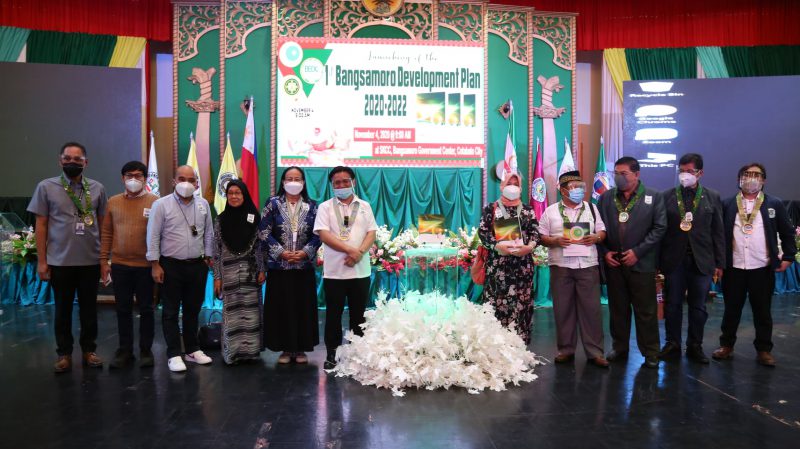COTABATO CITY — The Bangsamoro Planning and Development Authority (BPDA) headed by Bangsamoro Director General Engr. Mohajirin T. Ali together with BARMM Executive Secretary Abdulraof A. Macacua officially unveiled during its historic launch today, November 4, 2020 the first-ever Bangsamoro Development Plan (BDP) 2020-2022 held at Shariff Kabunsuan Cultural Complex, Bangsamoro Government Center, this city.
The plan is a first of its kind since it harmonizes with the existing development plans of the Bangsamoro government that will be implemented under the Parliamentary System of Government of the Bangsamoro Autonomous Region in Muslim Mindanao (BARMM).
Director General Engr. Mohajirin T. Ali said the plan articulates the overall thrust and directions of the BARMM for a three-year period and beyond.
“It takes into account the ARMM performances and lessons learned from the implementation of programs and projects in the ARMM-Regional Development Plan, 2017-2022, as well as, the priorities identified in other existing Bangsamoro Plans such as the Bangsamoro Development Plan (BDP) I and II of the MILF Bangsamoro Development Agency (BDA) and the Unified Bangsamoro Development Plan (UBDP) of the MILF and MNLF,” Ali said.
Ali added the overall goal of the plan is to uplift the lives of the Bangsamoro and establish foundations of self-governance through moral governance.
The 1st BDP 2020-2022 is aligned with the 12-point priority agenda of the Bangsamoro government and is also consistent with the national development’s direction as outlined in the Ambisyon Natin 2040, Philippine Development Plan (PDP) 2017-2022 and 0-10 Socioeconomic Agenda of President Rodrigo Roa Duterte.
Chief Minister Ahod B. Ebrahim emphasized that under his leadership, they pursued the plan’s formulation as part of the Bangsamoro government’s 12-Point Priority Agenda.
“I issued Memorandum Order No. 449 last August 15, 2019 which directed the formulation of the 1st Bangsamoro Development Plan (BDP) 2020-2022 through the five (5) Planning Committees (PCs) who facilitated the formulation process,” Ebrahim said.
Moreover, the plan was first adopted by the Bangsamoro Economic and Development Council (BEDC) on June 5, 2020 during its first regular meeting and was finally approved by the Bangsamoro Transition Authority (BTA) Parliament on July 3, 2020 during its second special session.
BTA Parliament Speaker Atty. Pangalian Balindong mentioned the major challenges to confront not only in the implementation but with the very formulation of the BARMM Transition Plan.
“I remain confident that we know we have taken the right direction in that regard; even observers agree, even praise and envy us for having had the opportunity to design our very own government,” Balindong said.
In a message relayed by OIC Undersecretary Mercedita Sombilla, National Economic and Development Authority (NEDA) Secretary Karl Kendrick T. Chua said that along with the entire national government, NEDA is fully committed to support the implementations of all initiatives and strategies of the 1st BDP, as well as the successful transition of the region for the development of BARMM.
In addition, Office of the Presidential Adviser on the Peace Process (OPPAP) Secretary Carlito Galvez who was represented by Assistant Secretary Wilben M. Mayor, extended his warmest congratulations to the BARMM Government, BTA Parliament, BEDC, and the BPDA for their untiring hardwork, dedication and determination just to fulfill their crucial mandate in serving the Bangsamoro.
Meanwhile, the plan was a result of the extensive series of planning workshops, writeshops and meetings between different ministries, agencies, and offices in the BARMM, and consultations with the local government units (LGUs), civil society organizations (CSOs), private sector organizations (PSOs), academe, and other stakeholders at the regional, provincial and municipal levels. Other guests in attendance were members of the Bangsamoro Parliament, representatives from ministries, agencies and offices in the BARMM, international development partners from the European Union (EU), Australian Embassy, International Organization for Migration (IOM), United Nations Populations Fund (UNFPA), Japan International Cooperation Agency (JICA), The Asia Foundation (TAF), Centre for Humanitarian Dialogue (CHD), and the United States Agency for International Development (USAID). (Lovella Lao-Lastimosa, IKMD, BPDA-BARMM)




